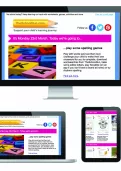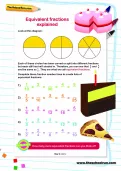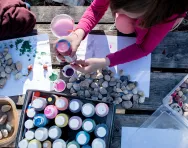Important update from TheSchoolRun
For the past 13 years, TheSchoolRun has been run by a small team of mums working from home, dedicated to providing quality educational resources to primary school parents. Unfortunately, rising supplier costs and falling revenue have made it impossible for us to continue operating, and we’ve had to make the difficult decision to close. The good news: We’ve arranged for another educational provider to take over many of our resources. These will be hosted on a new portal, where the content will be updated and expanded to support your child’s learning.
What this means for subscribers:
- Your subscription is still active, and for now, you can keep using the website as normal — just log in with your usual details to access all our articles and resources*.
- In a few months, all resources will move to the new portal. You’ll continue to have access there until your subscription ends. We’ll send you full details nearer the time.
- As a thank you for your support, we’ll also be sending you 16 primary school eBooks (worth £108.84) to download and keep.
A few changes to be aware of:
- The Learning Journey weekly email has ended, but your child’s plan will still be updated on your dashboard each Monday. Just log in to see the recommended worksheets.
- The 11+ weekly emails have now ended. We sent you all the remaining emails in the series at the end of March — please check your inbox (and spam folder) if you haven’t seen them. You can also follow the full programme here: 11+ Learning Journey.
If you have any questions, please contact us at [email protected]. Thank you for being part of our journey it’s been a privilege to support your family’s learning.
*If you need to reset your password, it will still work as usual. Please check your spam folder if the reset email doesn’t appear in your inbox.
Help your child learn to learn

1. Take a picture walk
Many children (and some adults!) try to examine a book as though their life depends on it, scanning and re-scanning every single word in the hope of absorbing the information like a sponge. This may work for some, but for others, Barbara and Terrence recommend doing almost the opposite.


Start a unique learning programme!
- Weekly programme for each school year
- Worksheets sent direct to your inbox
- Keeps your child's learning on track
"When you start a new chapter, go on a 'picture walk' through it. Scan it. Look briefly at the pictures, captions, and diagrams, but also at the section headings, bold words, and summary."
By doing this, your brain can prepare for what's coming, and it helps your mind to begin organising the information you're reading.
"It's a little like a closet. The picture walk gives you 'hangers' where you can organise the information you're reading. Without hangers, the clothes just fall on the floor in a jumble."
2. Learn when to focus, and when not to
Our brains are often using two different modes: the focus mode or the diffuse mode. When your brain is in focus mode, you're concentrating on the task at hand, but when you are in diffuse mode, you are relaxed and your mind is wandering. Barbara and Terrence explain that it is important to use both modes at different times and that they can both be used to learn. They suggest switching between the two when you are trying to learn something new.
Try focusing on the task at hand, but when you get stuck, let your mind wander for a short time. For instance, focus on answering a set of maths questions and then take a short break to play a video game, talk to friends, read a book or help someone with a simple task. But be sure that when you're in diffuse mode, like playing a game or reading, you are not focused on the learning task anymore.
"When you're in diffuse mode, your brain is working on the problem quietly in the background, although you're often not aware of it."
Don't forget to set a time limit when you want to go into the diffuse mode, though, or you could end up forgetting about the task altogether!
3. Break up your child's learning time with a tomato
Have you heard of the Pomodoro technique? It's often used as a study method for college students but can be applied successfully to young children too. Put simply, it involves using a timer to split your study and breaks into measurable chunks. The general rule of thumb is 25 minutes of learning, then the timer will go off and you can have a ten-minute break. This is called 'doing a Pomodoro'. The word is Italian and means tomato, like the tomato-shaped timers you can purchase for cooking.
You can repeat this process as many times as necessary but the point is to spend 25 minutes focused on one task and then ten minutes moving around, doing something completely different and relaxing your mind. The timings are up to you and your child. It may be that they can focus for 15 minutes, or perhaps 30 minutes, or that they need a slightly longer break. For some children, it will work better for you to allocate the times and give prompts, and others will prefer to structure their time themselves.
You could even go shopping with your child and pick out a fun timer they can use for their Pomodoros.
4. Learn with creative mental images
"If you convert a fact you're trying to remember into a picture, you can remember it more easily. If the picture is unusual, it's even easier to remember."
Research shows that our memories are much better at storing images than facts. If you can transform a fact you are trying to remember into an image in your mind, you are far more likely to recall the fact. If you can add movement to the image and play a quick video (or even a meme) in your mind, then that's even better!
Other suggestions for absorbing and recalling information include making up a song, making up metaphors, or even imagining that you are the object or idea you are trying to remember. "What's it like to be a star? Or a continent? Or a glacier? Or a tree growing in the sunlight? This might sound silly, but it works!" say Barbara and Terrence.
5. Healthy living helps you learn
"When you exercise, your brain makes a chemical called BDNF (brain-derived neurotrophic factor). BDNF makes your new neurons strong and healthy."
We often hear about the physical benefits of exercising, but Barbara and Terrence explain how exercise helps our brains too. "Just like fertiliser helps plants grow, BDNF helps neurons grow. Extra BDNF is produced by exercise." Exercise also releases serotonin and dopamine, which help you to come up with new ideas. "Exercise isn't just good for every organ in your body. It improves understanding, decision making, and focusing."
So next time your child is struggling with a difficult piece of homework, try using that diffuse time to get them to run around a bit and recharge those neurons! (Better still, run around with them and enjoy some of your own diffuse time!)
Extract adapted from Learning How to Learn: A Guide for Kids and Teens by Barbara Oakley and Terrence Sejnowski. Copyright © 2019.









